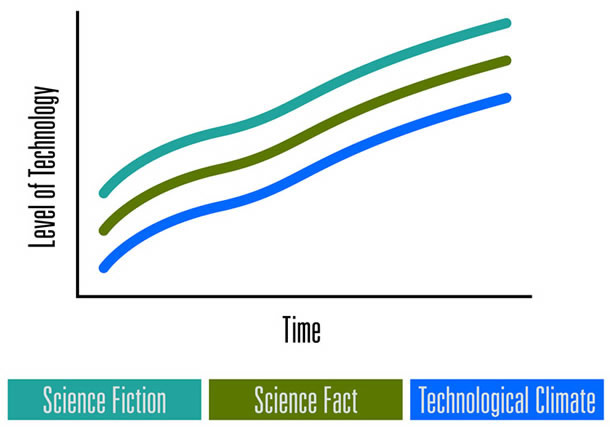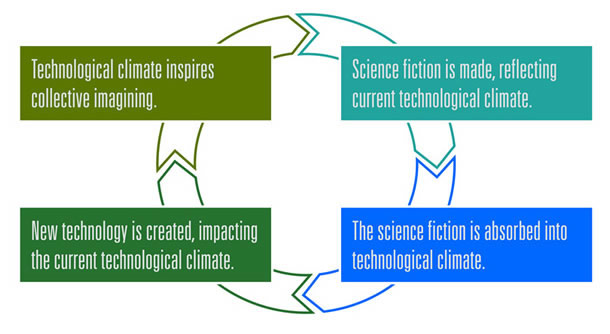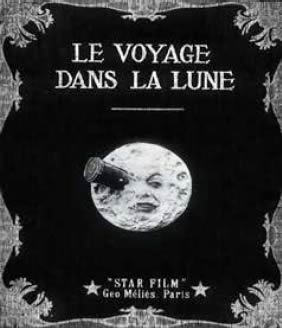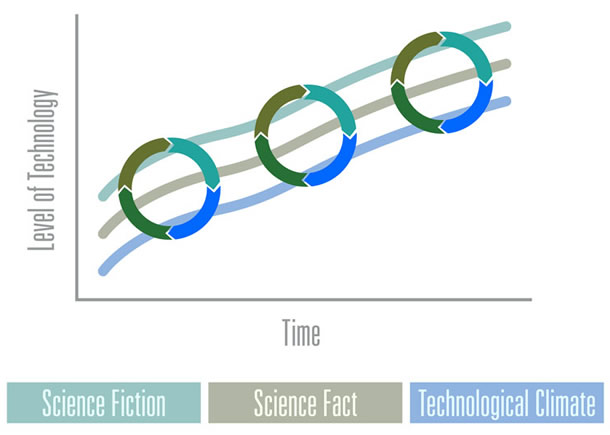Gene Roddenberry could never have imagined that a prop from his TV show would change the world, but that’s exactly what happened when he introduced the communicator on the first episode of Star Trek in 1966. Just six short years later, in 1973, Martin Cooper made the first public cell phone call from a handheld device. Afterward he acknowledged that Star Trek had inspired him to develop the technology.
This is not a unique a story. Rockets, geostationary satellites, and tablet computers all got their start in the creative minds of science fiction authors. And the creations of these authors, who were inspired by the science fact and fiction that came before them, went on to inspire the next wave of science fiction, creating a feedback loop of inspire, create, repeat.
To help predict where our technology is heading, it is important that we know how each step in the feedback loop works. Being able to understand the process will make us better designers and help us see the many ways we can directly impact the science of tomorrow.

The Technological Climate
While science fiction can both inspire future technology and explore the effects of those future technologies, it is important to remember that at the end of the day science fiction is storytelling. For an audience to understand those stories, it needs to be grounded in something that the audience is familiar with.
“The technological climate” is society’s appreciation for, and understanding of, the current level of technological advancement. Be it cell phones or cruise control, once the average person understands what a technology can do for them without thinking about how it actually works, that technology has been absorbed into the technological climate. It’s the idea that we get how to use stuff like touchscreens and WiFi, but maybe not the actual science of how it all works.
This collective understanding will always lag behind our current level of technological achievement. Science fiction, on the other hand, needs to stay ahead of our current level of technological achievement. That being said, anything that presents a world that is beyond our current level of technological achievement could technically be considered science fiction, but this also includes things that are so far beyond our level of comprehension they wouldn’t really make any sense. Creating a world beyond the audience’s understanding will get you nothing but blank stares and confusion. In the end, the sweet spot—where science fiction becomes comprehensible to the largest possible audience and can have the most impact—is in between those two where the science present and the science future blend together. What’s comprehensible in science fiction, however, does not always translate into something that is usable. The sweet spot for science fiction represents the upper limit when designing for the everyday world.
Cultural Understanding of Technology
In Fritz Lang’s classic Metropolis (1927), technology was operated using mechanical controls like levers. By 1987, the television show Star Trek: The Next Generation had replaced the mechanical controls with touch panels and voice control. Each piece of operating technology fit with the viewing audience’s general understanding of technology at that time. In 1927, mechanical controls made sense because that’s how people controlled everything else. Today, it makes sense that a spaceship would need something more advanced. As our relative understanding of technology improved, so did our assumptions about what would make sense in the future. Had touchscreens been imagined in 1927, showing them would have been more future-reaching, but also would have pushed the audience outside the boundaries of their understanding.

The Science Fiction Feedback Loop
Now that we’ve got a handle on how the technological climate is related to current science fact, how science fiction can’t stray too far ahead, and how all of these need to keep pace with one another, it’s time to get into how one influences the next, and so on.

See full text below
1. Science fiction is made, reflecting current technological climate
Science fiction literature “… can point to a series of themes that illuminate contemporary imaginings of the relationship between science, technology, and society.”
—Paul Dourish and Genevieve Bell, Resistance is Futile: Reading Science Fiction Alongside Ubiquitous Computing (2009)
In a scene from the 1902 film Le Voyage dans la Lune, explorers traveling from the earth to the moon climb inside a giant bullet and prepare to be shot out of a cannon. As they wave to the crowd the scene is full of pomp and circumstance complete with a grand marshal, a marching band, and a crowd of spectators who have come to watch. The film represents the technological climate of the time in that it adheres to the audience’s understanding of projectiles and in doing so, is able to convey a method for how space travel might work.
This depiction of space travel in Le Voyage dans la Lune shows us two things: in addition to moving the narrative along, it also reflects the optimistic and celebratory climate in which space travel was perceived at the time.

la Lune.
2. Science fiction is absorbed into the technological climate
“Because of its creative elasticity, sci-fi is able to make strange, implausible ideas mundane and every day. … We are drawn into the possibility that even our wildest imaginings can be realized. Whatever we can dream can happen.”
—Julian Bleecker, Design Fiction: From Props to Prototypes (2010)
Once science fiction has been put out there, the ideas can begin to be absorbed into the technological climate. The degree and speed at which they can be absorbed depends both on the film, show, or novel’s commercial success in the marketplace, and on the idea’s accessibility as a storytelling component. The more difficult a given concept is to understand, the less it will be absorbed (if it is absorbed at all). On the other hand, if an idea has clear, obvious value to enough people (Kirk’s communicator for example), even if it is technologically a long way off, it can be absorbed rather quickly.
3. New technology is created, impacting the current technological climate
“Research and engineering activities of NASA are frequently and quite explicitly founded upon the visions of exploration and expansion embodied by the Star Trek television series, and these visions—whether of portable communicators for easy communication, digital pads replacing paper, or virtual environments in which we can be immersed—have been explicitly invoked in contemporary research in human-computer interaction and ubiquitous computing.”
—Paul Dourish and Genevieve Bell, Resistance is Futile: Reading Science Fiction Alongside Ubiquitous Computing (2009)
While science fiction relies on the technological climate for guidance, the technological climate relies on science fact for direction. Like shouting over long distances, there is a delay between the introduction of new technology and its absorption into the technological climate. This delay is caused by the time it takes for a technology to be adopted into the mainstream; just because it exists, doesn’t mean that people know about it, or know what it means.
For science fact to have an impact on the technological climate, the technology needs to have been put into use in a very broad way. For example, while the computer mouse was invented in the 1960s, it wasn’t commonplace until desktop computing became prevalent many years later. It was only at that point that people began to understand how physical movements could be used to control computers.
4. Technological climate inspires collective imagining
“This is the way that science and design and fact and fiction collapse together. They all wonder what a world would be like, if… They all spark conversations that wonder and compel us to imagine things otherwise.”
—Julian Bleecker, Design Fiction: From Props to Prototypes
Once new ideas and concepts have become reality and they are absorbed into the technological climate, they begin to influence the next wave of collective imagining. In the technologically advanced society we live in today, new science fact tends to come from an established and well-financed industry. New science fiction, however, can come from anywhere. This collective imagining—basically the new science fiction—provides a springboard into what might happen next.
Having influenced science fact and that fact then influencing the next wave of science fiction, we have come full circle. While I’ve gone through the steps in a wash-rinse-repeat style sequence, the reality is that we are constantly starting, influencing, and repeating each of these steps over and over. Each new evolution of the techno-climate causes us to revisit ideas from the past, imagine new futures, and influence technology in ways never conceived before.

influenced by, and imagining new technology.
Future Visions
“Science fiction can be thought of as a storytelling genre that creates prototypes of other worlds, other experiences, other contexts for life, all based on the creative insights of the author.”
—Julian Bleecker, Design Fiction: From Props to Prototypes
Software companies like Microsoft and Apple like to influence us by broadcasting their visions of what’s next. These can be very expensive to produce and, in retrospect, have proven to be only partially accurate. For those not actively involved in their creation, they are most useful as a gauge of what the software companies want to achieve. As a form of science fiction, these visions need to sit close enough to science fact and the technological climate that the average person can understand what’s going on, while still presenting a vision interesting enough to get people excited about the new technology. In this respect they are like concept cars at an auto show, used both as a window into one potential future and as a marketing tool for gauging public interest.
The Mess of Reality
“When we talk of the mess, we want to suggest that the practice of any technology in the world is never quite as simple, straightforward,or idealized as it is imagined to be.”
—Paul Dourish, Genevieve Bell, Divining a Digital Future: Mess and Mythology In Ubiquitous Computing
The problem with these visions of the future is that they are too perfect, too polished. They exist in a space where nothing ever goes wrong and nothing ever breaks unless it is part of the story. I can understand that Microsoft wouldn’t be too interested in a promotional video depicting a future where Windows is crashing, but what about other sci-fi? Where are the competing technology companies in Star Trek? Does Kirk carry a dongle for recharging his communicator? If I need to plug in my cellphone once a day, and its range is pathetic by comparison, how does his get juice?
Part of the reason this doesn’t come up is that to the average person, this level of tech detail is not really all that interesting. The audience doesn’t really care if these high-tech toys even need to be recharged, only that they exist as tools for storytelling. And really, that’s fine. As designers, though, we are accustomed to thinking about these things, finding the edge-case is part of our job.
Influencing The Future
“Look, the best way to predict the future is to invent it.” —Alan C. Kay, Predicting the Future
This is where we as designers can make a difference. You don’t need to be a designer to know that reality always finds a way to put a wrinkle into your plans. But when it comes to new technology, being a designer does help us predict those wrinkles. Every time we create a prototype of a new idea we are, in a sense, crafting a potential future. Using our research skills, we are able to ensure that these prototypes match the needs of our target audience. With user testing we are able to refine and enhance its features and functionality, removing as many wrinkles as we can find.
The research phase of a project is a great place to incorporate the feedback loop. We can identify concepts in movies, books, and television that have influenced the target audience and our clients, including them in our reports as a baseline of their new scientific expectations. Similar to a competitive comparison, we could benchmark these concepts against the current market, identifying the strengths and weaknesses of each. We could even go so far as to demonstrate why one concept makes for a good design solution while another will not. Using those concepts we can establish predicted interactional expectations of our audience and support new designs, perhaps even identify upcoming technological trends.
The design process is, in large part, imagining, and there is no reason why we can’t take this one step further and use these same skills to solve real problems with technologies that don’t exist yet. This could work both for existing clients, as a suggestion of where they want to be headed, and for prospective clients, demonstrating forward thinking solutions.
At work we focus our skills on things that can be built and are to the benefit of our clients; we uncover real problems and solve them with real technologies. Once the process is complete, we show our clients how the design solution solves the problems of today. Going back to the science fiction feedback loop, if we are able to show people something new and desirable that solves not only problems today but into the future, even if it can’t actually be built today, we can influence the technological climate, collective imagining, and, if the right people see it, maybe even the science fact of tomorrow.
[greybox]
Figure 3 Description
A cycle, starting from the lower left:
- New technology is created, impacting the current technological climate
- Technological climate inspires collective imagining
- Science fiction is made, reflecting current technological climate
- The science fiction is absorbed into the technological climate
[/greybox]从《大都会》到《星际迷航》,科幻小说已经塑造了我们的集体想象力,并以意想不到的方式推动现有技术。科幻小说不只是关于宇宙飞船和激光枪——它反映我们的社会文化,并且是展示所构想的技术如何被真实用户应用的原型工具。实际上,富有想象力的人可以用科幻小说来深刻地影响未来科技。
文章全文为英文版메트로폴리스에서 스타트렉까지, 공상과학은 우리의 집단적 상상력을 형성해왔으며, 기존의 과학기술을 예측하지 못한 방식으로 발전시켜왔습니다. 공상과학은 단지 우주선과 광선검에 관한 이야기가 아니라 그것을 만들어 낸 문화를 보여주는 것이며, 상상의 기술이 실제 사람들에 의해 어떻게 이용될 수 있는지를 보여주는 시작품입니다. 궁극적으로 공상과학은 미래의 과학에 깊은 영향을 미칠 수 있도록 상상력을 가진 사람들에 의해 이용될 수 있습니다.
전체 기사는 영어로만 제공됩니다.De Metropolis a Star Trek, a ficção científica moldou nossa imaginação coletiva e impulsionou a tecnologia da época de maneiras jamais esperadas. A ficção científica não trata apenas de naves espaciais e pistolas de raios laser – é um reflexo da cultura na qual foi criada, e é uma ferramenta de prototipação que mostra como as tecnologias imaginadas podem ser usadas por pessoas reais. No final das contas, a ficção científica pode ser usada por aqueles com imaginação para causar um impacto profundo na ciência do amanhã.
O artigo completo está disponível somente em inglês.『メトロポリス』から『スタートレック』に至るまで、SFは我々の集合的想像力を形成し、現行のテクノロジーを予期せぬ方法で前進させてきた。SFは、宇宙船や光線銃のみについて語っているのではなく、SFが創作された文化を反映し、想像されたテクノロジーが現実の人々によってどのように使用されるかを示すプロトタイピングツールなのだ。究極的にSFは、将来のサイエンスに大きな影響を与えるほどの想像力をもつ人々によって使用される。
原文は英語だけになりますDesde Metrópolis hasta Star Trek, la ciencia ficción ha moldeado nuestra imaginación colectiva y ha hecho avanzar la tecnología existente de maneras impensadas. La ciencia ficción no se trata sólo de naves espaciales y pistolas de rayos, sino que es un reflejo de la cultura en la que se crea y es una herramienta de prototipado que muestra cómo las personas reales pueden usar tecnologías imaginadas. Como fin último, la ciencia ficción puede ser usada por aquellos que tienen imaginación para lograr un impacto profundo en la ciencia del mañana.
La versión completa de este artículo está sólo disponible en inglés.
